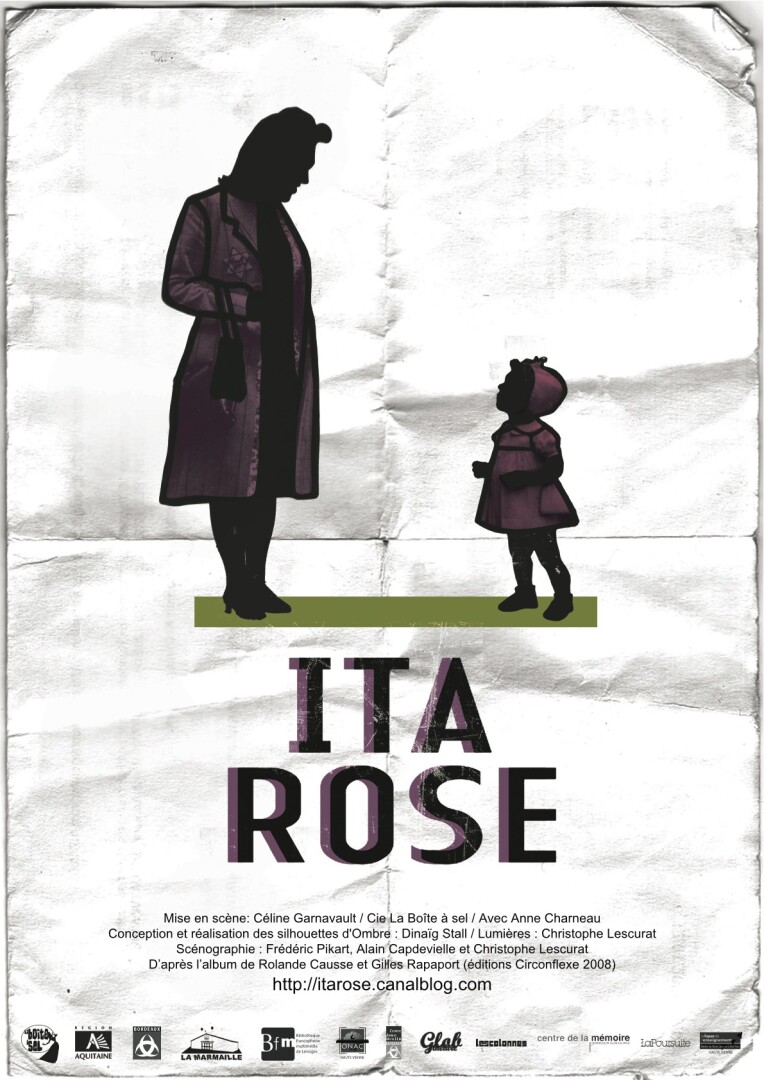THE STAGING
"It's a story that is not easy to hear, but it's a story that must be told."
This is how the tale of Ita-Rose and her family begins, as a speaker delivers it while opening her files, revealing cardboard silhouettes that she places one after the other on the desk. Immediately, these silhouettes, though motionless and frozen, become signs, as many symbols of what these people were. Then comes the Shadow, which appears and unfolds on the paperboard. By allowing the projection of emotions and memories, the Shadow provides access to an intimate perception of what is being told. With a small lamp in hand, the actress begins to compose the images of this story in the form of tableaux animated by the sole movement of light. By creating her own "machinery" without illusion, without pretension, she leaves all the space for the evocative power of the silhouettes and their shadows.
In a stripped-down space, a space designed economically for a scholarly speaker, this woman seeks to talk to us about humanity and to bring us closer to the past, or rather to that part of the past that is difficult to perceive in its reality. That part that we forget due to our inability to materialize it. The show "Ita-Rose" carries the voice of a woman, a mother, a resistance fighter, a voice that does not give up. It is this voice that must be heard, transmitted. Simply.
Céline Garnavault
THE SHADOW
The strength of the Ita-Rose album lies in presenting the facts without affect, almost starkly, without the slightest pathos. The narrative is accompanied by drawings and archival photos reworked by the illustrator Gilles Rapaport.
This work, with its contrasting graphics and vivid colors – under which the photos are nothing more than traces, reminiscences that are both distant and yet clear because they are anchored in our collective memory – this dense pictorial universe colors the almost disembodied narration and underscores the expressive power of its apparent simplicity.
For this story indeed happened, to that woman as to unfortunately many others, caught in the enormous machinery of the genocide orchestrated by Germany of the Third Reich. And this story haunts us too, we who belong to a generation that has known nothing of it except the stories that have been passed down to us.
We have inherited these historical facts that are so unbelievable (how many millions of deaths? does that number even make sense when we cannot even visualize it?) and yet true, of which we can ultimately grasp only moving fragments, bits of images that are necessarily incomplete. It is this both fragmentary and omnipresent aspect of memory related to the Holocaust, very sensitively rendered in the album by the illustrations of Gilles Rapaport, that brings us to the shadow.
Shadow theater, especially in its contemporary developments (working on scales thanks to the "detachment" of silhouettes from the screen, breaking the central screen into a multiplicity of projection surfaces, etc...) indeed seems to us the most capable of translating on stage the effect produced by the original illustrations. These are indeed very strong within the book, but it seems to us that they would lose readability in a stage use.
What makes their beauty in the book is that one can take the time to browse them, to decipher them, and also to compare them with the original photos reproduced at the end.
We also wish to preserve the mix of period photos and characters with very black and thick outlines and graphics made of voids and solids that evoke engraving techniques... and the silhouettes of cut-out shadows.
We will work on the three constitutive elements of the shadow: silhouette, light source(s), projection surface(s), in order to refine our universe and develop the language of the shadow not only in its plastic dimension but also and especially in its significant dimension. To give a concrete example, choosing the material or materials serving as the projection surface adds meaning to the overall image: projecting onto burlap "colors" the image in a completely different way than a projection onto silk...
The shadow allows for working with both silhouettes and synthetic images, almost symbolic, and with photos, period iconographic documents. It allows for blending the realism of archival documents with the striking shortcut of a silhouette that disappears, swallowed by darkness. It also allows for introducing movement into this pictorial universe, synonymous with life for the animated characters. And if movement signifies life, then immobility signifies death with immediate dramatic effectiveness.
Dinaïg Stall
